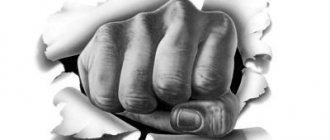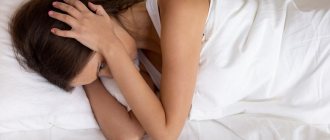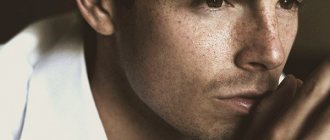Correct breathing during panic attacks: effective practical exercises
Not everyone knows that the most faithful companion of a panic attack is improper breathing! While we are being attacked by this “beast,” our heart rate increases and, accordingly, our breathing rate increases. In extreme situations, such a state is the body’s natural reaction to danger, but during a panic attack, a person sometimes simply “forgets” to exhale correctly. We inhale sharply and a lot, but exhale insufficiently and as if in a ragged, abrupt manner, which, of course, complicates the subsequent inhalation, and, accordingly, leads to a feeling of suffocation and lack of oxygen.
To normalize your breathing, make it smooth and natural, just learn a few simple exercises and practice them every time you have a panic attack.
Principles of proper breathing:
- Breathing should be done strictly “into the stomach”, and not into the chest! And this is the main principle of breathing exercises. To learn this technique, place your hand on your stomach and inhale until you feel it (the stomach) inflate. After exhalation, the stomach returns to its original position. By the way, this is how vocalists learn to breathe. If you find it difficult to understand this technique, I advise you to watch educational videos about vocal breathing online. They describe and show all the techniques in great detail.
- You should not take a lot of frequent and quick breaths, as this will only worsen your condition. You should always breathe slowly and evenly, sometimes taking sharp exhalations to relieve tension.
- Inhale through your nose and exhale through your mouth.
Exercises for practice
- Lie on your back, relax and place your hands on your stomach. Breathe slowly into your stomach, as described above. Focus completely on your breathing, trying to make it smoother and more natural.
- In the same relaxed position, take a calm, deep breath. Hold it for 3 seconds and then exhale sharply. Relax, count to 5, and then repeat inhaling and exhaling. Feel how muscle and mental tension goes away.
- Take a slow deep breath, hold your breath for 3 seconds, and then exhale the air in bursts, in portions on a count of 3, completely emptying your chest. This exercise helps eliminate excessive muscle tension and normalize normal breathing.
- The reverse exercise will also be very effective. Take 3 short and quick breaths, and exhale sharply, like a sigh of relief. As you exhale, you can imagine yourself freeing yourself from anxiety, fear, or tension. This technique allows you to get rid of the feeling of lack of air in a short time.
- And another common way to normalize breathing is breathing into a bag. This technique will make it much easier for you to do the exercises. Exhale into the bag or folded palms using the techniques described above.
Remember that control of breathing is control of a panic attack!
Causes
There are three groups of etiological factors:
1.
Psychogenic – family quarrels, divorce, betrayal, conflicts at work, etc.
etc. The occurrence of attacks of fear is preceded by the death of a loved one, electric shock, car accident, or illness. Sometimes attacks occur after watching emotional television programs or films. 2.
Biological – changes in hormonal levels (in women during pregnancy, after childbirth, during menopause), taking hormonal contraceptives, the onset of sexual activity, painful menstruation.
Panic attacks do not include conditions caused by diseases of the endocrine system (adrenal adenoma) and hyperfunction of the thyroid gland. 3.
Physiogenic – drug use, alcohol intoxication, weather sensitivity, high physical activity, acclimatization.
Panic attacks occur mainly in patients with certain personality traits: in women with drama and a desire to attract attention; in men – constant anxiety and increased concern for their health.
Stop the attack with medication
Drugs from the group of tranquilizers (anxiolytics or anti-anxiety drugs) help stop a panic attack if you take the pill at a time when it is still in its infancy.
Tranquilizers cannot be taken by everyone; they are sold by prescription, so they must be prescribed by a psychiatrist or psychotherapist.
Panic attacks. Why don't pills help?
How else can you activate the parasympathetic system?
· Meditation.
Scientifically speaking, meditation is a mental action aimed at bringing the psyche into a state of deep concentration. Many scientists have long viewed meditation critically, but now there is evidence that it increases the parts of the brain responsible for the production of the happy hormone dopamine. In addition, correctly performed practices allow you to slow down, release tension in the body, and reduce the level of anxiety and anxiety.
· Yoga.
There are countless types of yoga. Among others is Sudarshan Kriya Yoga, which is considered especially useful for relieving anxiety, stress, and insomnia. To experience its effect for yourself, try this exercise for a few minutes:
- Turn on your favorite relaxing music (the sounds of the sea or the sound of the wind may be suitable)
- Close one nostril with your thumb.
- Inhale slowly through the second nostril for 5 seconds.
- Release the first nostril, close the second and exhale slowly.
Repeat for at least 7-10 rounds.
· Massage of active biological points:
- between the eyebrows;
- on the wrist;
- in the hollow between the index finger and thumb.
Clinical picture
The duration of attacks is from 15 minutes to several hours, the frequency is from 2-3 times during the day or once a month.
As a rule, panic attacks occur suddenly, against a background of complete calm. But most patients claim that attacks more often develop under stress, in a small enclosed space, or in crowded transport. At the first attacks, a person does not understand what is happening to him. If the patient is very frightened, he suspects the presence of severe cardiovascular pathology, endocrine or nervous disorders, and calls an ambulance.
After the first panic attack, a person makes an appointment with various specialists, undergoes an examination, and suspects the presence of a rare disease. The patient concentrates excessively on his health, which aggravates the course of the attacks.
As a rule, panic attacks are repeated. Therefore, a person is constantly in tense anticipation of the next attack. If fear and anxiety arise in certain conditions and under the influence of certain factors, the patient begins to avoid similar situations. Worrying about having a panic attack in a particular location and then avoiding it is called agoraphobia. As a result of increased signs of agoraphobia, a person becomes antisocial, he is afraid to leave the house, and depressive states arise.
People aged 20-65 years are at increased risk of developing panic attacks; attacks are more common in people aged 25 to 40 years. Older people over 70 years of age are less likely to suffer from attacks.
What is breathing like?
Before talking about execution techniques, let's understand a little about the types of breathing itself. It happens:
· Top.
In this case, the diaphragm is practically not strained, and breathing is carried out through the upper part of the chest.
· Average
This is when air enters due to the expansion of the middle part of the chest, and the diaphragm moves down slightly.
· Nizhny.
The diaphragm is lowered as much as possible, the abdominal muscles are relaxed.
· Full.
It involves maximizing the filling of the lungs with air by combining all the techniques listed above.
· Reverse.
This is the tension of the abdominal muscles when inhaling, the lowering of the diaphragm.
· Delayed.
There is a pause between inhalation and exhalation. Often used in yoga, since the founders of the teaching implied that the body is filled with energy while holding the breath.
Breathe slowly
How to get rid of panic attacks? Slow breathing helps to cope with a rapid heartbeat and shallow breathing, which are both symptoms of a panic attack and its provocateurs. By breathing slowly, you send a signal to your brain to calm down. This is one of the most effective physiological ways to stop a panic attack.
Focus on your breathing. Inhale for one-two-three-four, hold your breath for one second, exhale for one-two-three-four. Look at your stomach (even through clothes): how it inflates as you inhale and retracts as you exhale.
Treatment of phobias and panic attacks at the Alliance Mental Health Center
Are panic attacks curable? Of course, this disease, along with phobias and other anxiety disorders, is treatable - you can learn to stop and prevent mild panic attacks and completely get rid of severe attacks.
A psychotherapist treats panic disorder. It will help you find the cause of panic and work through it during therapy, replacing negative, destructive attitudes with positive ones that give a feeling of confidence and control. If you don’t know how to live with a diagnosis of panic attacks, how to treat this disease and get rid of attacks, contact the Alliance Mental Health Center.
You will learn to anticipate an attack and not be afraid of it, accelerating its development, but to control its course and not let fear take over - to stop the development of the attack yourself.
In addition to cognitive therapy, course treatment for panic attacks includes: body-oriented therapy, relaxation training, biofeedback therapy and other techniques. For panic attacks, drug treatment is used only as an additional method in the initial stages, and gradually patients can find a state of peace without sedatives.
Treatment of panic attacks in Moscow
The most important thing in treating panic disorder is to seek help from a specialist. Drug therapy is not always effective and is prone to addiction. How many people are treated for panic attacks by therapists and cardiologists - for a long time and without results - it’s scary to imagine. It is important not to let the situation take its course, because constant panic attacks are exhausting and deprive you of confidence and joy in life.
If you don’t know how to treat panic attacks, anxiety, and unreasonable fear do not allow you to live in peace - just come to the Alliance Mental Health Center or call for a first consultation. For panic disorder, treatment will definitely bear fruit, the main thing is to start.
Doctors at the Alliance Mental Health Center will help you overcome panic disorder. An integrated approach to diagnosis and treatment has given hundreds of patients a happy life without fear and panic. It is possible to get rid of attacks - come and we will definitely help you.
Types and types of panic attacks
Panic attacks are divided into the following types depending on the nature of their manifestation:
- Vegetative. They have pronounced symptoms - chills, trembling of the limbs, rapid heartbeat, heavy sweating, pain and dizziness in the head, etc.
- Phobic. Anxiety arises in a specific place or in a specific situation.
- Hyperventilation. This type is characterized by symptoms such as shortness of breath without physical exertion and painful sensations in the muscles.
- Conversion. The person loses his voice, and pain occurs in the left side of his chest. He may lose consciousness or be on the verge of it. At the same time, he is tormented by thoughts of death.
- Affective. The patient's mood changes, depression and inexplicable melancholy occur. Physically, you feel tired and exhausted.
- Senestopathic. “Goosebumps” are felt throughout the body, tingling and numbness occur in the limbs.
- Depersonalization-derealization. A person feels disconnected from reality and the world around him. Or it seems to him that everything around him is not happening for real.
Types of panic disorders depending on the situation:
- Spontaneous. Anxiety arises “out of the blue”, without any obvious reason.
- Situational. Panic is felt during a specific situation. This may be a premonition of a quarrel, conflict, before taking an exam, in the event of real dangers, threats to life and health.
- Conditional-situational. Symptoms appear due to the influence of any “activators” on the body. This includes taking hormonal pills, drinking alcohol, using drugs, drinking strong tea or coffee.










